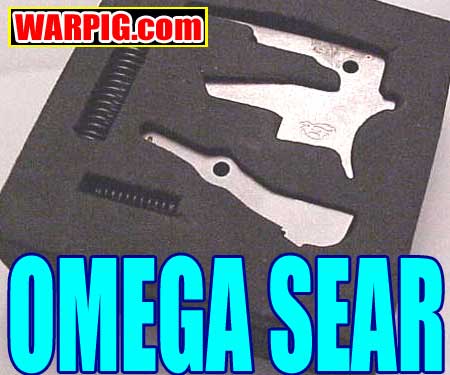  |
|
|
|
|
|
|
  |
|
|
|
|
|
|

What
do you think?
|

Omega Sear and Trigger Set For the WGP Autococker by Bill Mills
Roller sears have become a popular accessory for the WGP Autococker. In a stock Autococker, the trigger is not a pivoting piece as it is with many paintguns. Instead, the trigger is a metal plate that slides back and forth in the trigger frame. The resulting trigger feel is akin to the sliding trigger of a Colt 1911 automatic pistol. An angled ledge on the back of the trigger slides against the rounded lower front edge of the sear. The sear is a lever, which holds the hammer back. When the trigger is pulled, the angled ledge lifts the front of the sear, dropping its back end and releasing the hammer to hit the valve.
Roller sears have a small ball bearing roller on their front. Micro sized bearings let the roller’s smooth surface glide across the trigger plate allowing for a smoother trigger pull. Omega goes a step further with their trigger plate. As the trigger is pulled, it has a tendency to try and rotate clockwise (as viewed from the paintgun’s right side) because the finger presses below its centerline. When the trigger is returning, the return spring is pressing at the bottom, while the timing rod and 3 way valve are offering resistance at the top. This causes a counter-clockwise rotation. This is in part why two finger sliding triggers have a tendency to bind, and never became popular – they move the finger contact point lower amplifying this problem. The Omega trigger plate and sear are both made of hardened steel for durability.
As an additional feature, the Omega sear has a notch on its back end that engages the sear spring, preventing it from shifting or sliding. Also included in the plate and sear set’s dense foam packaging are a new sear and trigger return spring. Installation takes a few minutes. For testing, the set went into a 1998 Autococker with stock molded trigger frame. First, the trigger frame was removed. For players wanting to keep their safety (many remove it as part of a trigger job) it is important not to lose the safety spring and it’s ball bearing at this point. When they are removed, the retaining clip can be pulled off of the safety, and the safety can be slid out the side of the frame. The trigger shoe comes off, and the sear’s pivot pin is pulled out the side. The only tools used for this process are the hex wrenches of appropriate sizes, and a pair of pliers to pull out the sear’s pivot pin. The trigger group then slides easily out of the grip frame, and is replaced with the Omega components, then the procedure is reversed for reassembly.
|
| Copyright © 1992-2019
Corinthian Media Services. WARPIG's webmasters can be reached through our feedback form. All articles and images are copyrighted and may not be redistributed without the written permission of their original creators and Corinthian Media Services. The WARPIG paintball page is a collection of information and pointers to sources from around the internet and other locations. As such, Corinthian Media Services makes no claims to the trustworthiness or reliability of said information. The information contained in, and referenced by WARPIG, should not be used as a substitute for safety information from trained professionals in the paintball industry. |